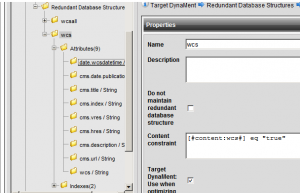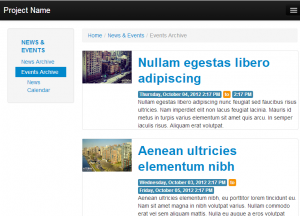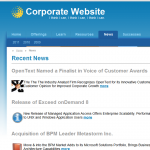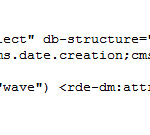Recently in the community I’ve been advocating and drumming up support for DS REST API and Jian, Kim, and Manuel have been discussing MS Plugins using AJAX to call RQL. I recently got an opportunity to give them a test drive to see how they will work for rapid prototyping a solution for a Proof of Concept (POC). I was impressed.
The scenario (as originally understood):
To create a set of JSP pages that provide access to WSM
1)DS to display different contents based on date range, resolution, and later an audience category for personalization.
2) Remote access to Asset Manager contents, and on selection return relative paths for where published files would reside.
DS REST API In Depth:
After installing (used the quick start guide for backup) and testing base functionality. I jumped back to Management Server to create contents with metadata to drive the searches. Some assigned by categories and keywords, some by standard fields, and some embedded in the content class templates. After publishing I created a redundant database structure.

I created a new handler by copying the existing Target DynaMent handler. I removed authentication for the handler, as this is a POC it just make things simpler. I developed a query to the specified my parameters.
http://host/api/1/newtarget.html?dbs=wcs&project=demo&include-mode=content,content&chunksize=1&chunk=1&sortedby=cms.date.wcsdatetime&ignore-constraints=completely&sortorder=desc&attributepath=none&constrainttime=20110623&hres=300
I added a couple DynaMents to write constraints for me based on values of ‘constrainttime’ and ‘hres’. And I had a single content returned per date/resolution. I finished it up by adding a simple HTML XSLT so the content of this one item is accessible as if it were called directly. The rest was some JSP to scrape characters from a URL into a StringBuffer. Much more sophisticated option is possible but it is a POC.
RQL via AJAX
var loginguid=””;
var sessionguid=””;$(document).ready(function() {// hide search result area
$(“#searchresult”).hide();
if($.cookie(“assetlogin”) == null || $.cookie(“assetsession”) == null || $.cookie(“assetlogin”) == “” || $.cookie(“assetsession”) == “”)
{
login();
}else{
if(“<%= session(“sessionkey”) %>” ==”” || “<%= session(“loginguid”) %>”==””){
loginguid=$.cookie(“assetlogin”);
sessionguid=$.cookie(“assetsession”);
DisplayAssets(“FE46C4F25F4847F4A983C6F41EDC42A3”);
}else{
//alert(“asp vars”);
loginguid=”<%= session(“loginguid”) %>”;
sessionguid=”<%= session(“sessionkey”) %>”;
DisplayAssets(“FE46C4F25F4847F4A983C6F41EDC42A3”);
}
}
});
function DisplayAssets(FolderGuid)
{
if(FolderGuid == “”)
{
$(“#searchresult .content”).append(“<div class=\”error\”>Error</div>”);
return;
}
$(“#searchresult .content”).empty();
//load simple page info
var strRQLXML = padRQLXML(“<MEDIA><FOLDER guid=\””+FolderGuid+ “\” subdirguid=\””+FolderGuid+”\”><FILES action=\”list\” view=\”list\” sectioncount=\”-1\” maxfilesize=\”0\” attributeguid=\”\” searchtext=\”*\” pattern=\”\” startcount=\”1\” orderby=\”name\”/></FOLDER></MEDIA>”);
$.post(“/CMS/PlugIns/RemoteAssetManager/rqlaction.asp”, { rqlxml: strRQLXML },
function(data){
// add stuff to search results
if($(data).find(“FILE”).attr(“name”) != null)
{
//add on click alert http://host/saq/images/imagename
$(data).find(‘FILE’).each(function(){
$(“#searchresult .content”).append(“<div style=\”border: 2px solid grey; padding 15px;\”><a onclick=\”alert(‘URL for Integration Externally: http://host/url/images/”+$(this).attr(“name”)+”‘)\” href=\”#img=” + $(this).attr(“name”) + “\”><br/><img style=\”border:3px solid black;\” src=\”http://win-kk55dom76sa/cms/”+$(this).attr(“thumbnailpath”)+”\” /><br/>” + $(this).attr(“name”) + “</a><br/> </div>”);
});
}
else
{
$(“#searchresult .content”).append(“<div class=\”error\”>Folder with guid ” + FolderGuid + ” not found.</div>”);
}
$(“#searchresult”).show();
}, “xml”);
}
function login(){
// login
var strLoginRQLXML = “<IODATA> <ADMINISTRATION action=\”login\” name=\”admin\” password=\”dontdothis\”/></IODATA>”;
$.post(“/CMS/PlugIns/RemoteAssetManager/rqlaction.asp”, { rqlxml: strLoginRQLXML },
function(data){
//handle the login request
loginguid=$(data).find(‘LOGIN’).attr(“loginguid”);
userguid=$(data).find(‘LOGIN’).attr(“userguid”);
//sessionguid=$(data).find(‘LOGIN’).attr(“guid”);
$.cookie(“assetlogin”, loginguid);
//alert(“loginguid: “+loginguid);
//”<IODATA loginguid=\”<%= session(“loginguid”) %>\” sessionkey=\”<%= session(“sessionkey”) %>\”>” + innerRQLXML + “</IODATA>”;
var strProjectRQLXML = padRQLXMLNoSession(“<ADMINISTRATION action=\”validate\”><PROJECT guid=\”0B7FE095D7814EE48B95B2E2A41A0BA0\” /></ADMINISTRATION>”);
//alert(strProjectRQLXML);
$.post(“/CMS/PlugIns/RemoteAssetManager/rqlaction.asp”, { rqlxml: strProjectRQLXML },
function(data){
//handle the login request
sessionguid=$(data).find(‘SERVER’).attr(“key”);
$.cookie(“assetsession”, sessionguid);
DisplayAssets(“FE46C4F25F4847F4A973C6F41EDC42A3”);
}, “xml”);
return “”;
}, “xml”);
return “”;
}
function padRQLXML(innerRQLXML)
{
return “<IODATA loginguid=\””+loginguid+”\” sessionkey=\””+sessionguid+”\”>” + innerRQLXML + “</IODATA>”;
}
function padRQLXMLNoSession(innerRQLXML)
{
return “<IODATA loginguid=\””+loginguid+”\”>” + innerRQLXML + “</IODATA>”;
}
This made a quick and easy UI to include via a similar JSP to the ones used for Delivery Server. This could be expanded on by
Result:
Both satisfied the technical requirements as they were understood. Some on the fly reconfiguration during a break was able to more accurately meet the customers requirements.
Time Frame:
Total time <16 hrs
Facts:
This includes download, install, configuration of REST project. A good amount of this time was spent coding the JSP to include the results of my REST services. I will be honest I’m really a novice with limited hands on experience. Only some rusty revision of existing RQL scripting as background and an existing AJAX plugin as guide.









